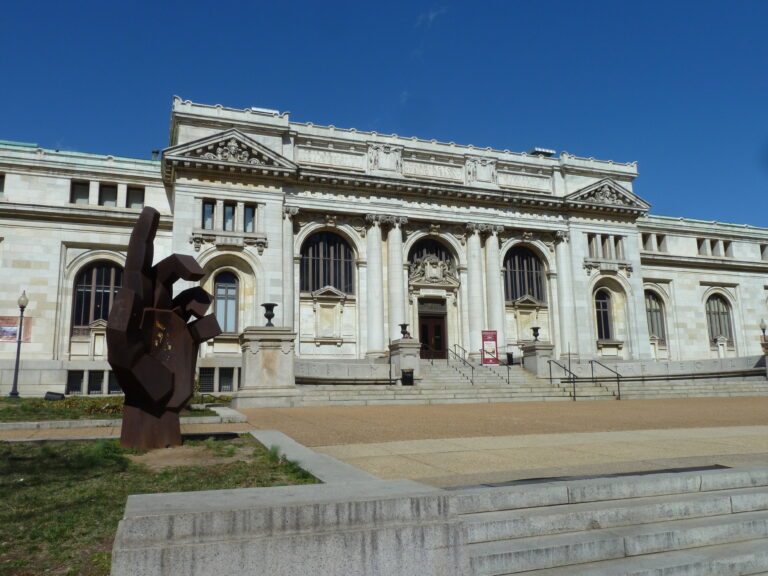Physical Address
304 North Cardinal St.
Dorchester Center, MA 02124
Physical Address
304 North Cardinal St.
Dorchester Center, MA 02124

The Carnegie Library in Washington, D.C. is now home to the world’s newest Apple Store following an expensive rehabilitation funded by the retailer. Originally built as a public library in 1903, it reopened its doors to the public on May 11, 2019 following decades of disuse, neglect, and a slew of failed attempts to repurpose the building as a museum. While some are fretting that a historic building owned by the city has been turned over to commercial use, we can rest assured that the Historical Society of Washington, D.C., the current leaseholder to the building, made the right decision. More than fifteen years ago, Niskanen Center founder Jerry Taylor and his then-colleague at the Cato Institute, Peter Van Doren, had a novel proposal to solve an intractable political dispute about the Arctic National Wildlife Refuge (ANWR), a wilderness area in northeast Alaska that is home to large populations of wildlife and vast, untapped petroleum deposits. In the early 2000s, the Bush Administration proposed opening the refuge to oil drilling in the wake of rising crude oil prices. Naturally, the usual suspects came out in favor or against the proposal. Environmentalist detractors worried that a pristine wildlife area could be ruined by any drilling and the possibility of leaky pipelines. Advocates, on the other hand, claimed only a tiny sliver of land was needed to extract billions of dollars of oil and the refuge would remain largely untouched. The benefits of oil drilling, proponents argued, would be widely shared because oil is used in so many parts of economy. Taylor and Van Doren’s proposal was simple: the federal government should give ANWR, in its entirety, to the Sierra Club or some other environmentalist group, including full rights to use or transfer the land as they see fit. While the Sierra […]
Coauthored with Emily Hamilton Last week, the autonomous vehicle company Waymo began testing cars in Chandler, AZ with no employees sitting in the front seat. While Waymo is busy creating systems of vehicle-mounted sensors that allow cars to safely navigate existing urban infrastructure and obstacles, some cities are pursuing plans to build “smart streets” that broadcast information about roads and potential hazards to autonomous vehicles. The American history of auto-centric infrastructure demonstrates that building specific infrastructure for autonomous vehicles may have long-lasting negative consequences. Waymo’s cars rely on both detailed maps and car-mounted lidar sensors that “see” the world around them in order to follow their route and to to avoid collisions. While the current technology is very safe, car-mounted sensors remain imperfect. As Tim Lee points out, there are reasons that Waymo launched in Chandler: its sunny weather, wide streets and minimal pedestrian traffic. Fully autonomous vehicles will need even better sensors than those that are currently available to drive safely in snowy conditions and in places with less regular streets that may confuse a vehicle’s sensors. Some analysts have advocated for publicly-provided smart streets and smart intersections that could limit the need for vehicle-mounted sensors and, perhaps, speed the adoption of autonomous vehicles. My colleague Brent Skorup has this view: Car-mounted sensors often confused by road materials (a shift from dirt to gravel or asphalt), reflective buildings, bridges, or even the weather. Roadside sensors not only mitigate these problems, but also reduce the computing load on car-mounted systems, because the vehicles have to make fewer snap decisions. There’s a way to get this information to vehicles quickly and accurately. Just as lawmakers and city planners started laying asphalt, installing streetlights, posting speed limits, and zoning property to accommodate Henry Ford’s cars, we need to design roads and infrastructure […]

President Trump has threatened to withhold all federal funds from so-called sanctuary cities–municipal governments that do not enlist their police departments in the president’s mass deportation plan. If he makes good on his threat, cities that insist on maintaining their sanctuary status can offset revenue losses with two policies: liberalizing land-use regulation and depoliticizing public land sales. It’s unclear exactly how much money each city would lose by maintaining its sanctuary status, but New York City, to name one example, relies on federal funding for 10% of its budget, according to state comptroller estimates. A sudden drop of that magnitude would devastate many jurisdictions, and Miami-Dade County has already caved. However, a handful of cities with high rents and very restrictive land-use regulations could dramatically increase property tax revenue and the value of city-owned real estate through liberalization. Millions of Americans would love to live in cities like New York, Los Angeles, San Francisco, Seattle, San Jose, Austin, Portland, and Denver, but legal restrictions on what can be built limit the number of housing units available and increase the cost of each unit. Some estimates have found that regulation alone accounts for fifty percent of the cost of housing in San Francisco. At the same time, land-use regulation has the opposite effect on the price of land itself. A plot of land with limited legal potential for development is worth much less than a plot a developer could use to build a large, lucrative building. Economist Keith Ihlanfeldt has found that the decrease in land values more than offsets the increase in home prices—meaning some cities are decreasing potential revenues by restricting development. San Francisco has large neighborhoods of single-family homes where rent levels would sustain large apartment towers. The drastic mismatch between what is currently allowed and what consumers demand suggests that land values would skyrocket if restrictions were relaxed. […]

The Cato Institute’s Vanessa Brown Calder is skeptical of the Obama administration’s suggestion that state governments can play a role in liberalizing land-use regulation, a policy area usually dominated by local governments. In an otherwise thoughtful post responding to a variety of proposals, she writes that federal and state-level bureaucrats should step aside to allow local advocacy groups to fill the void. She asks, “Who better to determine local needs than property owners and concerned citizens themselves?” Pretty much anyone, really. Local control of land-use regulation is a mistake and concerned citizens in particular are ill-suited for making decisions about their neighbors’ property. Supporters of free societies usually oppose local control of basic rights for good reason. Exercising one’s rights can be inconvenient for or offensive to nearby third parties. Protesters slow traffic, writers blaspheme, rock bands use foul words, post-apartheid blacks live wherever they choose with no regard for long-held South African social conventions, and so on. These inconveniences obviously don’t override rights to freedom of expression, but lower levels of government might be persuaded by people whose sensibilities are offended by these expressions. People are more likely to favor restrictions on rights when presented with a specific situation than they are when asked about general principles. People are even more likely to favor restricting a specific, disliked person’s rights. The landmark First Amendment case, National Socialist Party of America v. Village of Skokie, is instructive. The plaintiffs, American Nazis planning a parade through a neighborhood populated by Holocaust survivors in Illinois, sued on First Amendment grounds when the local government tried to prevent them from carrying swastikas. The Supreme Court eventually ruled in favor of the Nazis because the First Amendment protects peaceful demonstrations with no regard for the vile or hateful content of the ideas being promoted […]